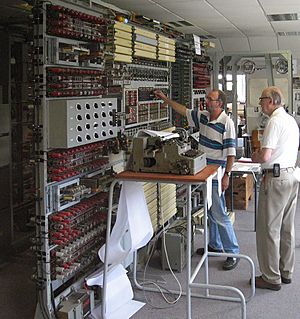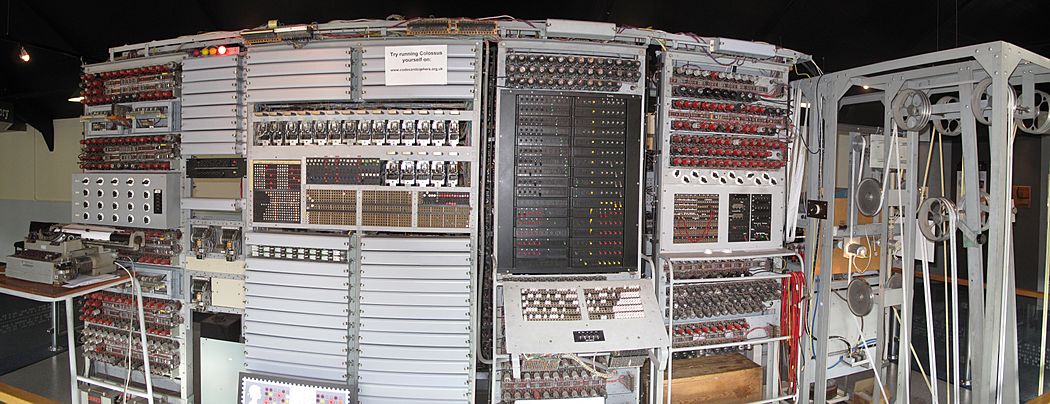Tommy Flowers facts for kids
Quick facts for kids
Tommy Flowers
|
|
|---|---|

Flowers, possibly taken around the
time he was at Bletchley Park |
|
| Born |
Thomas Harold Flowers
22 December 1905 Poplar, London, England
|
| Died | 28 October 1998 (aged 92) Mill Hill, London, England
|
| Nationality | British |
| Education | University of London |
| Occupation | Engineer |
| Known for | Colossus computer |
| Spouse(s) |
Eileen Margaret Green
(m. 1935) |
| Children | 2 |
Thomas Harold Flowers (born December 22, 1905 – died October 28, 1998) was a brilliant English engineer. He worked for the British General Post Office. During World War II, Tommy Flowers created something amazing. He designed and built a machine called Colossus. This was the world's first electronic computer that could be programmed. Its main job was to help break secret German codes.
Contents
Who Was Tommy Flowers?
Tommy Flowers was born in Poplar, London, on December 22, 1905. His father was a bricklayer. Tommy was very smart and loved to learn.
Tommy's Education and Early Career
He started as an apprentice in mechanical engineering. This was at the Royal Arsenal in Woolwich. While working, he also took evening classes. He studied at the University of London and earned a degree in electrical engineering.
In 1926, he joined the General Post Office (GPO). This was the main telecommunications company in Britain. By 1930, he moved to the Post Office Research Station. This station was located in Dollis Hill, north-west London.
In 1935, Tommy married Eileen Margaret Green. They had two sons, John and Kenneth.
From 1934, Tommy began exploring new ideas. He wanted to use electronics in telephone exchanges. These are the places where phone calls are connected. By 1939, he had designed equipment using many electronic valves. He realized that these valves could be used reliably. This was important for building fast computing machines.
Tommy Flowers and World War II
Tommy Flowers first helped with codebreaking in February 1941. His boss, W. Gordon Radley, was asked for help. The request came from Alan Turing. Turing was a famous mathematician at Bletchley Park. This was a secret government place for breaking codes. Turing wanted Tommy to build a special counter. It was for a machine called the Bombe. This machine helped to decode German Enigma messages.
The "Counter" project was stopped later. But Turing was very impressed with Tommy's work. In February 1943, Turing introduced Tommy to Max Newman. Newman was working on breaking another German code. This code was called "Tunny" by the British. It was made by a complex German machine called the Lorenz SZ40/42. This system was much harder to decode than Enigma. It needed too many tries to do by hand. Tommy Flowers and Frank Morrell designed a machine called the Heath Robinson. It tried to automate the process of breaking the Lorenz code.
Building the Colossus Computer
Tommy Flowers had an even better idea. He suggested building a more advanced electronic system. His team called it Colossus. This new machine would use many electronic valves. It would also use only one paper tape, not two. This made it much simpler to operate.
Some people were unsure if Colossus would work. They thought using so many valves would make it unreliable. But Tommy explained that the British telephone system used thousands of valves. He knew they could be reliable if used correctly. The managers at Bletchley Park were not fully convinced. But they told Tommy to go ahead on his own.
So, Tommy built Colossus at the Post Office Research Labs. He even used some of his own money to help. He had met Alan Turing earlier and they got along well. But other people, like Gordon Welchman, doubted Tommy's ideas. They preferred older methods.
Despite the success of Colossus, the Heath Robinson machine was still useful. Tommy Flowers designed an improved version called Super Robinson. This machine could run four tapes. It was used for specific codebreaking tasks. On June 2, 1943, Tommy Flowers was recognized for his work. He was made a member of the Order of the British Empire.
Tommy's boss, W. G. Radley, fully supported the Colossus project. Tommy's team worked very fast. They built the first Colossus machine in just eleven months. The staff at Bletchley Park immediately called it 'Colossus'. This was because of its huge size.
The first Colossus Mark 1 was much faster and more flexible. It had 1,500 valves. It ran at Dollis Hill in November 1943. It was then sent to Bletchley Park in January 1944. It started working in early February. The math and methods for Colossus were developed by W. T. Tutte and his team. Colossus proved to be very effective against the Lorenz SZ42 machine.
Tommy Flowers was already working on Colossus Mark 2. This new version would use 2,400 valves. The first Mark 2 started working at Bletchley Park on June 1, 1944. It provided very important information for the upcoming D-Day landings. These landings were planned for June 5.
Tommy later shared a story about a meeting on June 5. General Dwight D. Eisenhower was with his staff. A messenger brought a note with a Colossus decrypt. This message confirmed that Adolf Hitler did not want more troops sent to Normandy. Hitler still thought the Normandy landings were a trick. Eisenhower read the message and told his staff, "We go tomorrow."
Earlier, Colossus decoded a report from Field Marshal Erwin Rommel. This report was about German defenses. It showed that one planned drop site for US paratroopers was a German tank base. So, the site was changed.
Ten Colossus machines were built and used during World War II. An eleventh was ready when the war ended. Most of them were taken apart after the war. Only two were moved to a British Intelligence department. They were used until 1959 and 1960.
Tommy's Life After the War
After the war, Tommy Flowers did not get much public recognition. He was even in debt because he used his own money to build Colossus. The government gave him £1,000. But this did not cover all his personal costs. He shared much of this money with his team.
Tommy tried to get a loan to build another Colossus-like machine. But the bank refused. They did not believe such a machine could work. Tommy could not tell them he had already built many. His work on Colossus was a secret under the Official Secrets Act.
He continued working at the Post Office Research Station. He led the Switching Division. His group pioneered work on electronic telephone exchanges. They completed a basic design around 1950. This led to the Highgate Wood Telephone Exchange. He also helped develop ERNIE, a machine used for premium bond draws. In 1964, he moved to Standard Telephones and Cables Ltd. He continued to develop electronic telephone switching. He retired in 1969.
It was not until the 1970s that Tommy's work became widely known. His family only knew he had done some 'secret and important' work. In 1976, he wrote a book called Introduction to Exchange Systems. It was about the engineering of telephone exchanges. Tommy Flowers passed away in 1998 at the age of 92. He was survived by his wife and two sons.
Awards and Recognition
- 1973: He became an honorary Doctor of Science at Newcastle University.
- 1983: He was the first person to win the Martlesham Medal. This was for his achievements in computing.
- 1993: He received a certificate from Hendon College. This was for completing a basic computer course.
Tommy Flowers' Legacy
Tommy Flowers is remembered in several ways. The old Post Office Research Station site is now a housing area. The main building is flats, and a road is named Flowers Close. The London Borough of Tower Hamlets, where he was born, also honored him. A technology center for young people, the Tommy Flowers Centre, opened there in 2010.
In September 2012, his wartime diary was shown at Bletchley Park. A road in Kesgrave, near the BT Research Laboratories, is named Tommy Flowers Drive.
On December 12, 2013, a memorial was unveiled. This was 70 years after he created Colossus. British Telecom (BT) commissioned a life-size bronze statue of him. It was unveiled by Trevor Baylis at Adastral Park. This is BT's research center. BT also started a computer science scholarship and award in his name.
In 2016, BT opened the Tommy Flowers Institute. This institute helps train postgraduates for the ICT industry. It brings together companies and researchers. They work on challenges like cybersecurity and big data. In 2018, a room at the Institution of Engineering and Technology in London was named the Flowers Room.
Rebuilding Colossus
A working Colossus Mark II was rebuilt by volunteers. The team was led by Tony Sale. The rebuilding project took place between 1993 and 2008. This amazing machine is now on display. You can see it at The National Museum of Computing at Bletchley Park.
Tommy Flowers knew that Tony Sale was rebuilding the machine. He shared details about its original design and how it was built. This information was very important for the reconstruction.
See also
 In Spanish: Tommy Flowers para niños
In Spanish: Tommy Flowers para niños



